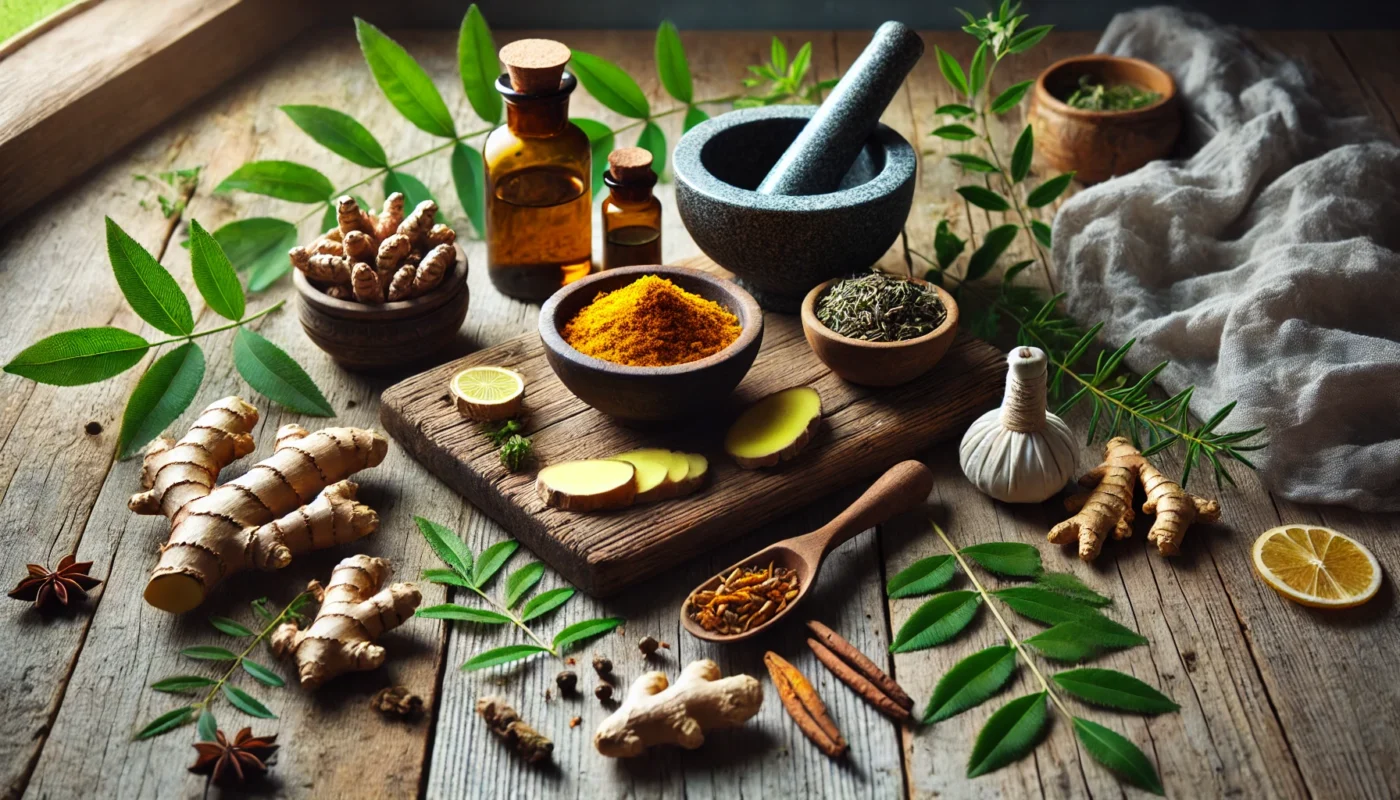The quest for pain relief is as old as humanity itself. From ancient times, herbal remedies have been employed to alleviate discomfort. Today, with growing awareness of the potential side effects of synthetic drugs, there’s a resurgence of interest in natural pain management strategies. But what makes these natural alternatives so appealing?
You may also like: 20 Powerful Anti-Inflammatory Foods
Historical Use of Herbal Remedies
Throughout history, cultures around the world have relied on the healing properties of plants to manage pain. Ancient Egyptians used willow bark for its analgesic properties, while Chinese medicine has long employed ginger and turmeric in its treatments. These traditional practices laid the foundation for modern interest in herbal remedies.
Growing Concerns Over Synthetic Drugs
The increasing scrutiny over the side effects associated with synthetic painkillers has fueled interest in natural alternatives. Many people experience adverse reactions to non-steroidal anti-inflammatory drugs (NSAIDs), including stomach ulcers and increased blood pressure. This has led to a search for safer, more sustainable options.
The Appeal of a Holistic Approach
Natural pain relief often involves a holistic approach to health. Instead of just masking symptoms, herbal remedies can support the body’s healing processes. This comprehensive perspective not only addresses the root causes of pain but also promotes overall well-being and balance in the body.
Environmental and Economic Factors
Natural remedies are often more environmentally sustainable and economically accessible than pharmaceuticals. The cultivation and harvesting of medicinal plants tend to have a lower environmental impact. Additionally, many herbs can be grown at home, reducing the cost and dependency on commercial products.
Personalized Health Solutions
One of the most compelling aspects of natural pain relief is the ability to tailor treatments to individual needs. Unlike one-size-fits-all pharmaceuticals, herbal remedies can be customized based on personal health profiles, preferences, and responses, making pain management a more personalized experience.
Top Natural Alternatives to Ibuprofen
Let’s explore some effective herbs and natural remedies known for their pain-relieving properties.
Turmeric
Turmeric, renowned for its vibrant yellow hue, contains curcumin, a compound with potent anti-inflammatory effects. Studies have shown that curcumin can be as effective as ibuprofen in managing pain and inflammation without the associated risks.
Understanding Curcumin’s Role
Curcumin is the active ingredient in turmeric responsible for its anti-inflammatory properties. It works by inhibiting certain molecules that play a significant role in inflammation. This makes it particularly useful for conditions like arthritis and muscle soreness.
Ways to Incorporate Turmeric
There are multiple ways to incorporate turmeric into your daily routine. It can be consumed as a supplement or added to foods like curries and smoothies. For enhanced absorption, pair turmeric with black pepper, which contains piperine, a compound that increases curcumin’s bioavailability.
Scientific Backing
Numerous studies support the efficacy of turmeric as a pain relief agent. Research has demonstrated its potential in reducing pain and improving function in individuals with osteoarthritis, a common condition characterized by joint pain and stiffness.
Ginger
Ginger is another kitchen staple with powerful anti-inflammatory and analgesic properties. It’s particularly effective for muscle pain and soreness, making it a favorite among athletes.
Active Compounds in Ginger
Ginger contains gingerols and shogaols, compounds that possess anti-inflammatory and antioxidant effects. These compounds work by inhibiting the production of pro-inflammatory cytokines, which are involved in the body’s pain response.
Methods of Consumption
Ginger can be enjoyed in various forms, such as fresh slices in tea, powdered in culinary dishes, or taken as a concentrated supplement. Its versatility makes it easy to integrate into any diet, providing natural pain relief without side effects.
Research Evidence
Scientific research supports ginger’s role in pain management, particularly for conditions like osteoarthritis and menstrual pain. Studies have shown that ginger can significantly reduce pain and improve mobility, offering a natural alternative to traditional painkillers.
Willow Bark
Historically used for pain relief, willow bark contains salicin, a compound similar to aspirin. It’s effective for back pain, headaches, and inflammatory conditions.

The History of Willow Bark
Willow bark’s use dates back to ancient civilizations, including the Greeks and Native Americans, who utilized it for its pain-relieving properties. It was the precursor to aspirin, one of the most widely used painkillers today.
How to Use Willow Bark
Willow bark is available in various forms, including capsules, teas, and tinctures. When using willow bark, it’s essential to follow dosing instructions carefully, as excessive consumption can lead to side effects similar to those of aspirin.
Clinical Studies and Efficacy
Clinical studies have confirmed willow bark’s efficacy in treating conditions such as lower back pain and osteoarthritis. Its natural composition makes it a viable option for those looking to avoid synthetic medications.
Boswellia
Also known as Indian frankincense, boswellia is prized for its anti-inflammatory effects, particularly for arthritis and joint pain.
Mechanism of Action
Boswellia works by inhibiting the production of leukotrienes, substances that can cause inflammation in the body. This mechanism makes it particularly effective for managing chronic inflammatory conditions like rheumatoid arthritis.
Forms and Dosages
Boswellia is typically consumed in capsule form, but it can also be found in topical creams for localized pain relief. Dosage recommendations vary, so it’s important to adhere to product guidelines and consult with a healthcare provider.
Supporting Research
Studies have shown that boswellia can significantly reduce pain and improve physical function in individuals with arthritis. Its long-term safety profile makes it an attractive alternative to conventional pain medications.
Capsaicin
Derived from chili peppers, capsaicin is known for its ability to deplete substance P, a compound involved in transmitting pain signals.
Understanding Capsaicin’s Benefits
Capsaicin’s pain-relieving properties stem from its ability to reduce substance P, a neurotransmitter that communicates pain signals to the brain. By decreasing substance P levels, capsaicin can effectively alleviate pain.
Application Methods
Capsaicin is commonly used in topical creams and patches, providing targeted relief for conditions like arthritis and neuropathic pain. It’s important to start with a low concentration to assess tolerance, as capsaicin can cause a burning sensation.
Evidence-Based Outcomes
Research supports the use of capsaicin for pain management, particularly in conditions like post-herpetic neuralgia and diabetic neuropathy. Its localized application minimizes systemic side effects, making it a safe option for many individuals.
Arnica
Arnica is a popular remedy for bruises, sprains, and muscle soreness. It works by reducing inflammation and pain when applied topically.
The Science Behind Arnica
Arnica contains compounds such as sesquiterpene lactones, which have anti-inflammatory and analgesic effects. These compounds help reduce swelling and pain, making arnica an effective remedy for soft tissue injuries.
Forms of Arnica
Arnica is available in creams, gels, and ointments for topical use. It’s crucial to apply it only to intact skin to avoid irritation or adverse reactions. Homeopathic formulations of arnica are also available for internal use, but their efficacy is debated.
Clinical Validation
Clinical studies have shown that arnica can effectively reduce pain and swelling in conditions like osteoarthritis and post-surgical recovery. Its natural composition and minimal side effects make it a preferred choice for many seeking natural pain relief.
Devil’s Claw
This herb, native to southern Africa, has been used traditionally to treat arthritis and lower back pain. Studies suggest it may be as effective as conventional pain relievers.
Active Components in Devil’s Claw
Devil’s claw contains iridoid glycosides, primarily harpagoside, which are believed to possess anti-inflammatory and analgesic properties. These compounds help alleviate pain by reducing inflammation in the body.
Usage and Dosage
Typically consumed as capsules or tablets, devil’s claw is also available in powdered form for teas. It’s important to follow recommended dosages and consult a healthcare provider, especially for those with underlying health conditions.
Research Insights
Research indicates that devil’s claw can effectively reduce pain and improve mobility in individuals with osteoarthritis and lower back pain. Its natural origin and efficacy make it a popular alternative to pharmaceutical pain relief options.
Practical Strategies for Natural Pain Management
Incorporating natural pain relief strategies into your routine requires more than just knowing which herbs to use. Here are some practical tips:

Consult with a Healthcare Professional
Before starting any new supplement or remedy, it’s crucial to consult with a healthcare provider, especially if you have existing health conditions or are taking other medications.
Importance of Professional Guidance
Healthcare professionals can provide valuable insights into which natural remedies may be most effective for your specific condition. They can also help monitor interactions with existing medications, ensuring safety and efficacy.
Customizing Your Approach
Working with a healthcare provider allows for a tailored approach to pain management. They can recommend specific dosages and combinations of herbs that align with your health goals and lifestyle.
Addressing Safety Concerns
Consulting with a professional helps mitigate risks associated with natural remedies, such as allergies or contraindications with other treatments. This proactive step ensures a safer transition to natural pain management.
Combine Remedies for Synergistic Effects
Some natural remedies can be more effective when used together. For instance, combining turmeric with ginger can enhance their anti-inflammatory effects.
Understanding Synergy
Synergy occurs when two or more substances work together to produce a greater effect than they would individually. This concept is particularly relevant in herbal medicine, where combinations can enhance therapeutic outcomes.
Effective Combinations
Combining certain herbs can amplify their pain-relieving properties. For example, turmeric and ginger both possess anti-inflammatory effects, and when taken together, they can offer enhanced relief for conditions like arthritis.
Tailoring Combinations
Experiment with different combinations of herbs to find the most effective blend for your needs. Keep in mind that individual responses may vary, so it’s important to monitor effects and adjust as necessary.
Lifestyle Modifications
In addition to herbal remedies, consider incorporating lifestyle changes such as regular exercise, a balanced diet, adequate hydration, and stress-reducing practices like yoga or meditation to support overall pain management.
The Role of Diet and Nutrition
A balanced diet rich in anti-inflammatory foods can complement herbal remedies. Incorporating foods like leafy greens, nuts, and fatty fish can help reduce inflammation and support overall health.
Exercise and Movement
Regular physical activity is crucial for maintaining joint flexibility and reducing pain. Low-impact exercises like swimming, walking, and yoga are particularly beneficial for individuals with chronic pain conditions.
Mind-Body Practices
Stress-reducing practices such as yoga, meditation, and deep breathing exercises can help alleviate pain by promoting relaxation and reducing tension in the body. These techniques offer a holistic approach to pain management.
Monitor and Adjust
Keep track of your symptoms and the effectiveness of the remedies you try. This will help you and your healthcare provider make informed decisions about your pain management strategy.
Keeping a Pain Journal
Recording your experiences in a pain journal can provide valuable insights into what works and what doesn’t. Note the type of pain, severity, and any remedies used, along with their outcomes.
Evaluating Effectiveness
Regularly assess the effectiveness of your natural pain management strategy. If a particular remedy isn’t providing the desired relief, consider adjusting the dosage or trying a different combination of herbs.
Collaborating with Healthcare Providers
Share your observations with your healthcare provider to refine your pain management approach. Their expertise can help guide adjustments and ensure that your strategy remains safe and effective.

Conclusion
Natural alternatives to ibuprofen offer a promising approach to pain management for those seeking to minimize reliance on pharmaceuticals. With a variety of herbs and holistic strategies available, you can tailor a regimen that aligns with your health goals and lifestyle. Remember, the journey to managing pain naturally is personal and may require some experimentation to find what works best for you.
By understanding the benefits and applications of these natural remedies, you can take proactive steps towards a healthier, pain-free life. Always prioritize safety and consult healthcare professionals when exploring new treatments. With the right approach, managing pain naturally can be an empowering and effective choice for long-term wellness.
Embracing a Natural Approach
Embracing a natural approach to pain management involves a commitment to exploring alternative options and making informed choices. This path offers an opportunity to take control of your health and well-being.
Fostering a Wellness Mindset
Adopting a wellness mindset encourages a focus on overall health rather than just symptom relief. By integrating natural remedies and lifestyle changes, you can enhance your quality of life and reduce reliance on pharmaceuticals.
Empowerment Through Knowledge
Educating yourself about natural pain relief empowers you to make choices that align with your values and health goals. This knowledge fosters confidence and autonomy in managing your pain naturally.
Further Reading:
Natural Pain Relief: 9 Alternatives to Ibuprofen, Acetaminophen or Aspirin
natural remedies, pain management, healthcare provider, herbal medicine, anti-inflammatory, lifestyle changes, wellness mindset, turmeric, ginger, exercise, nutrition, mind-body practices, pain journal, holistic health, empowerment, safety in remedies
Important Note: The information contained in this article is for general informational purposes only, and should not be construed as health or medical advice, nor is it intended to diagnose, prevent, treat, or cure any disease or health condition. Before embarking on any diet, fitness regimen, or program of nutritional supplementation, it is advisable to consult your healthcare professional in order to determine its safety and probable efficacy in terms of your individual state of health.
Regarding Nutritional Supplements Or Other Non-Prescription Health Products: If any nutritional supplements or other non-prescription health products are mentioned in the foregoing article, any claims or statements made about them have not been evaluated by the U.S. Food and Drug Administration, and such nutritional supplements or other health products are not intended to diagnose, treat, cure, or prevent any disease

